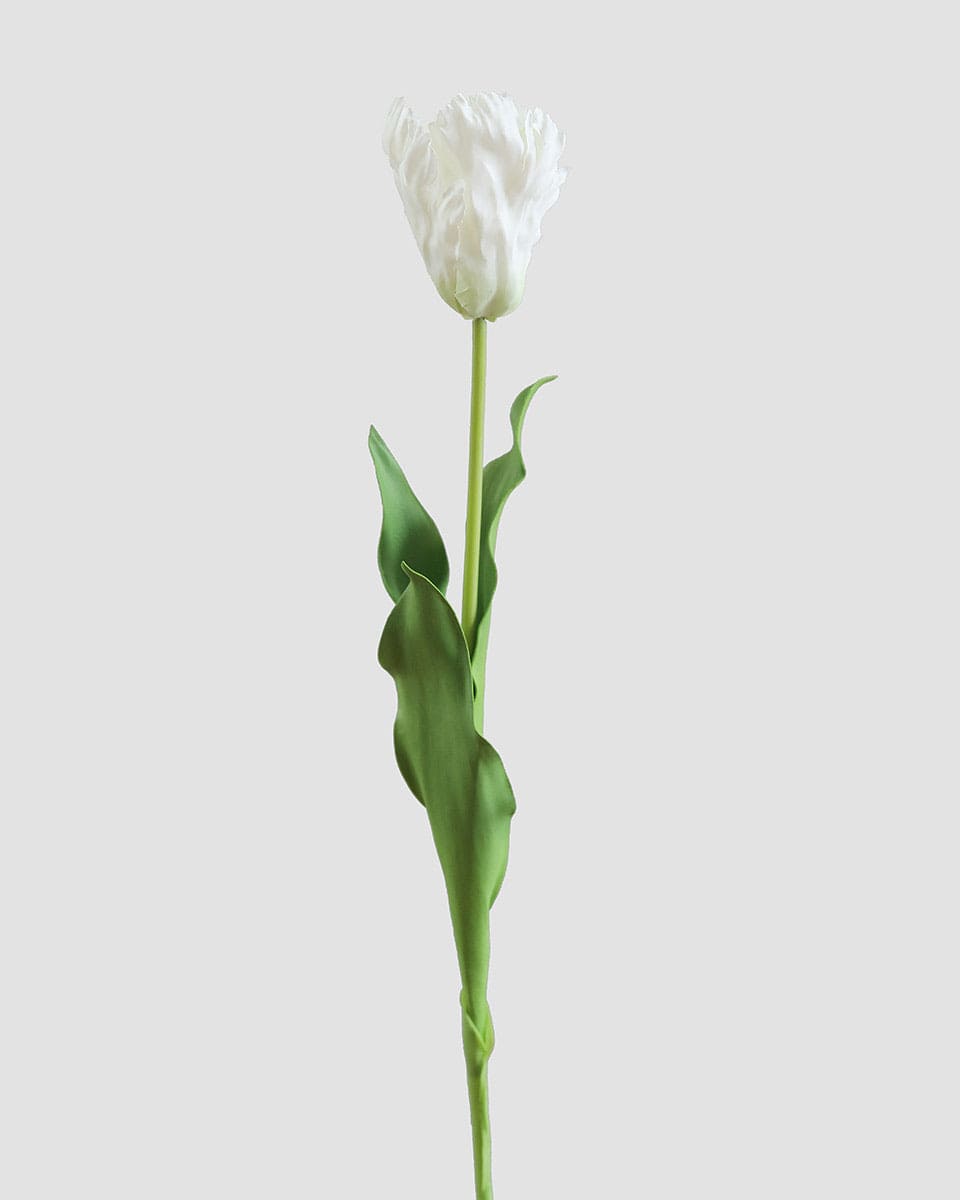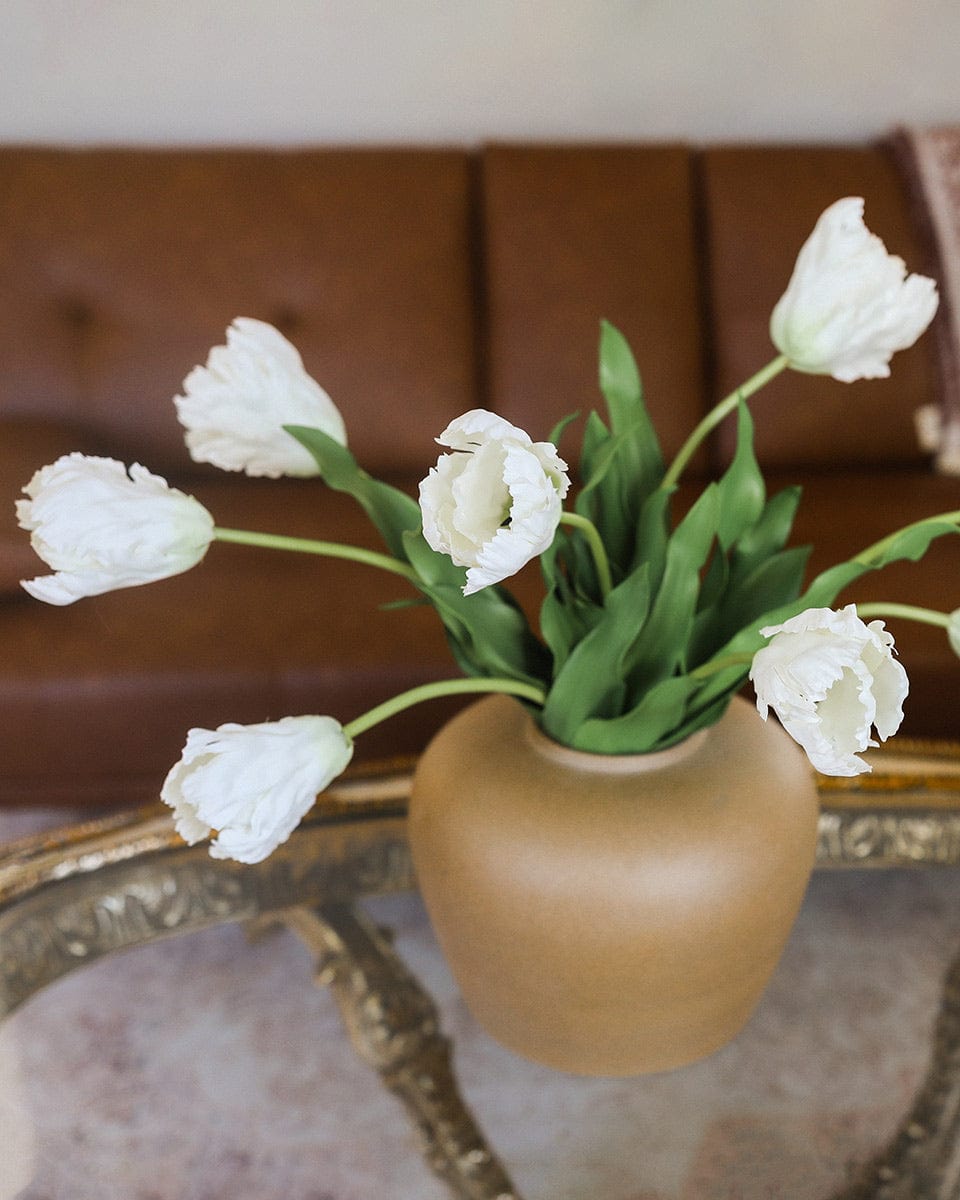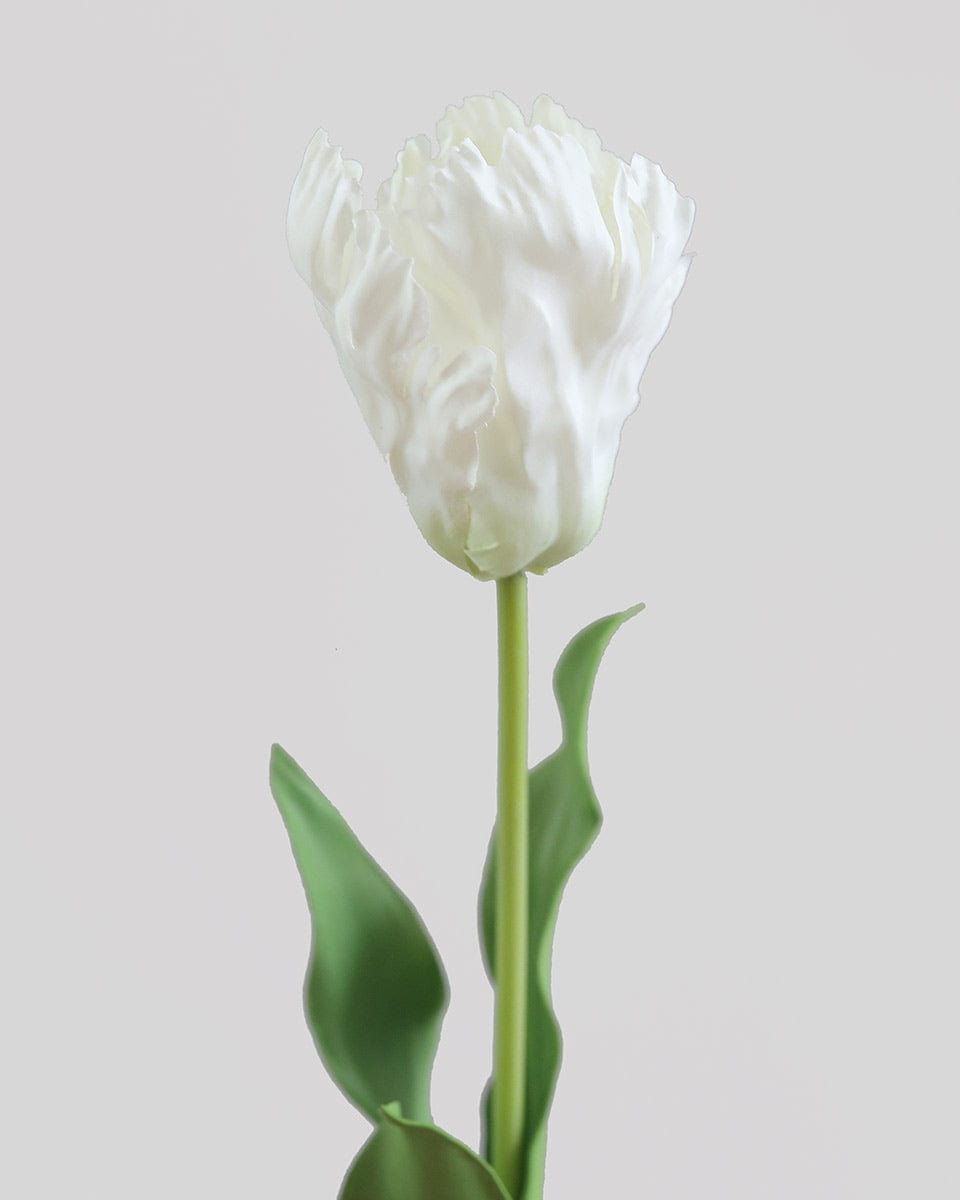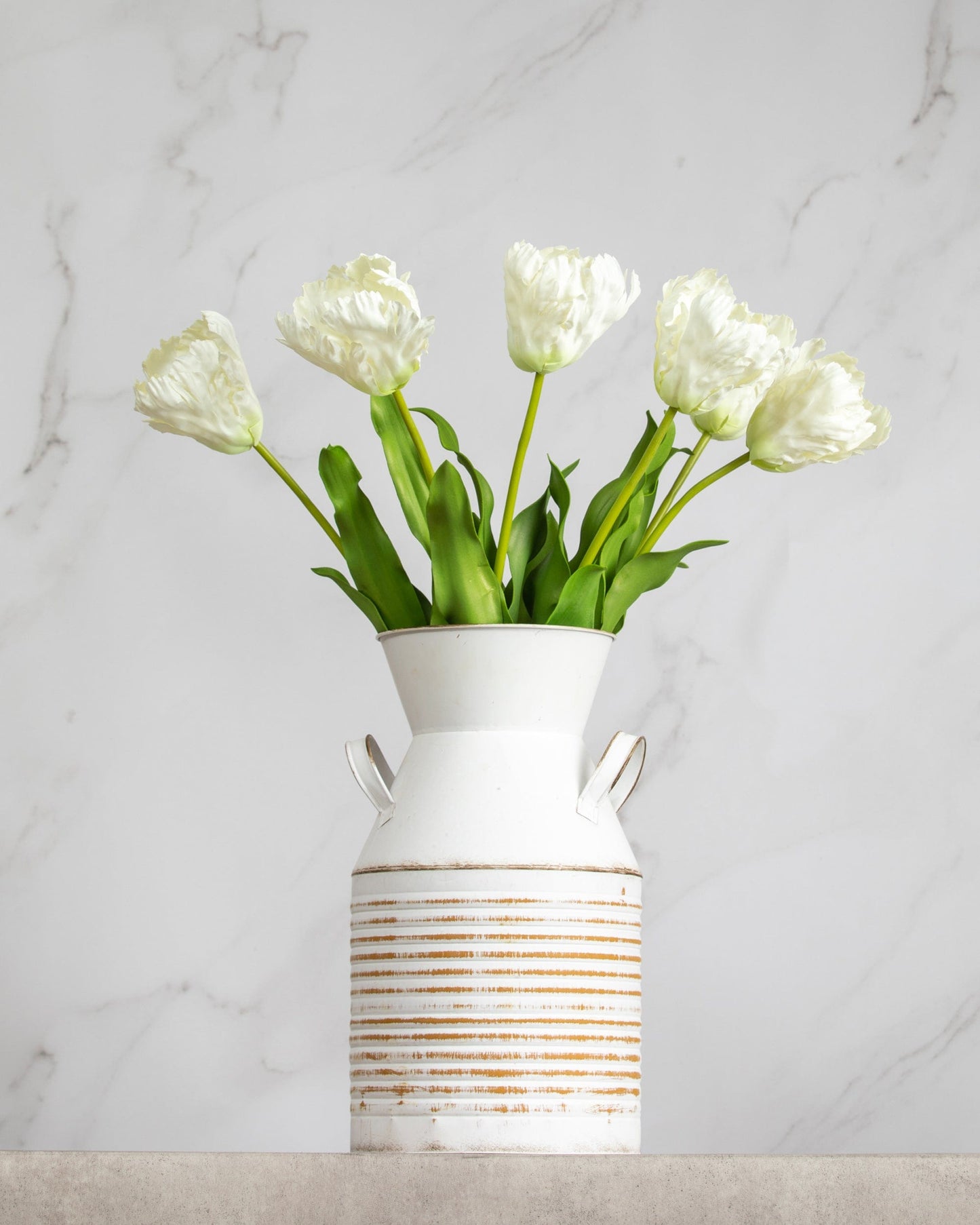



This artificial tulip boasts a creamy white hue, its petals gracefully unfurl to reveal a subtle touch of green, adding a delicate hint of nature's embrace along the bottom.
The real touch texture mimics the softness of freshly bloomed tulips. Each intricate detail, from the feathery fringes to the gently undulating curves, is thoughtfully replicated to create a captivating visual and tactile experience.
Grace your home decor with the everlasting beauty of our white real touch parrot tulip. Whether showcased individually or arranged in captivating bouquets, it will infuse any setting with an air of sophistication and timeless elegance.
Height: 27 Inches
Stem only Height: 10 Inches
Max Bloom Diameter: 4 Inches
Bloom Height: 4 Inches
Weight: 0.11 lbs
Composition: 20% Polyester, 10% Plastic, 40% EVA, 20% PVC, 10% Wire.
Real Touch Flower
- The long stem is designed to be folded whichever way you need it to go, and back again. It can easily be folded up on itself (and back) to more easily fit into your container, or trimmed entirely with a pair of wire cutters
- Not designed for outdoor use
- For details on how your products arrive - See here.
- For cleaning and care - see here.
This artificial tulip boasts a creamy white hue, its petals gracefully unfurl to reveal a subtle touch of green, adding a delicate hint of nature's embrace along the bottom.
The real touch texture mimics the softness of freshly bloomed tulips. Each intricate detail, from the feathery fringes to the gently undulating curves, is thoughtfully replicated to create a captivating visual and tactile experience.
Grace your home decor with the everlasting beauty of our white real touch parrot tulip. Whether showcased individually or arranged in captivating bouquets, it will infuse any setting with an air of sophistication and timeless elegance.
Height: 27 Inches
Stem only Height: 10 Inches
Max Bloom Diameter: 4 Inches
Bloom Height: 4 Inches
Weight: 0.11 lbs
Composition: 20% Polyester, 10% Plastic, 40% EVA, 20% PVC, 10% Wire.
Real Touch Flower
- The long stem is designed to be folded whichever way you need it to go, and back again. It can easily be folded up on itself (and back) to more easily fit into your container, or trimmed entirely with a pair of wire cutters
- Not designed for outdoor use
- For details on how your products arrive - See here.
- For cleaning and care - see here.
60 Day Trial
Ultra-Realistic Artificial Flowers
2 Year Warranty
Luxury Real Touch Tulips That Look Astonishingly Real
Incoporates Real Touch Technology for an Organic Feel
Design Endless Bouquets
Beautiful Blooms Without the Sneezing or Mess
Perfect for sensitive spaces and allergy sufferers - all the beauty of fresh flowers with zero pollen or irritants. No clean up required for wilting petals, leaves or stamen.
Save Thousands On Fresh Flowers
Enjoy flawless blooms for years while saving thousands on fresh flower replacements.
60-Day Home Trial Guarantee
Display your new botanicals in your home for 60 days. Arrange them, style them, and live with them.
Not completely in love? Just return them!
Trusted by 50,000+ Interior Designers, Wedding Planners & Flower Lovers


Beautiful Quality
Very pleased with my first order of real touch flowers. The camelias, white roses, and anemones are beautiful quality.. Already ordered again!

Cesia J.

Really Great Product
Really great product, looks like the photos. Delivered in a secure, carefully packed box in the time frame posted.

Kevin R.

Quality is Amazing
The flowers are the most beautiful I've used in arrangements. The red magnolias pop with vibrant color... the quality is amazing and worth it.

Jean M.

Very Realistic
Great quality. Very realistic. Added the pop of color to my vase

Letica A.
Read More Reviews
Why Choose Prestige Botanicals?
Prestige Botanicals
Other artificial flowers
Indistinguishable from Real Flowers
Handmade Construction, and hand painted finishes over 90 days
High quality construction materials
Built to last decades
Flexible, shapeable stems and leaves for total styling control
Rich, multi-tonal hues with natural color variations
60 Day Money Back Guarantee
Patanted unique 'Real Touch' Technology
Exclusive Product - not available anywhere else
Mass Produced
Crafted by Hand, Perfected by Time
Crafted over 90 days, every stem tells a story of dedication through our meticulous artistry and attention to detail.
- Each petal individually cut, dyed, and shaped by hand—no two flowers are exactly alike
- Proprietary seven-stage development process creates unmatched realism and natural movement
- Every bloom undergoes twenty-three quality checks before being deemed worthy of your home
Pristine Packaging for Perfect Arrivals
Our arrangements arrive as works of art, beautifully presented and perfectly preserved.
- Signature long boxes: Specially designed to protect each delicate stem.
- Premium tissue wrapping: Keeps every petal pristine and picture-perfect.
- Reliable delivery times: Tracked and scheduled to ensure your botanicals arrive exactly when you expect, in flawless condition.
FAQs
Our botanicals are individually crafted using premium materials and advanced techniques that capture the subtle details of real flowers - from the delicate petal textures to natural color variations. While craft store alternatives might cost less initially, our flowers maintain their beauty for years, making them more cost-effective long-term than both regular artificial and fresh flowers. Many of our customers mention that guests can't distinguish them from real flowers, even up close.
Each product listing includes detailed measurements and scale references. For arrangements, we recommend:
- Large spaces (entryways, dining tables): 28-43" stems
- Medium spaces (coffee tables, side tables): 20-27" stems
- Small spaces (bathrooms, small vases): 12-19" stems We also offer complimentary design consultations for larger projects to ensure you get the perfect scale for your space.
We've developed a specialized packaging system that protects each bloom during shipping:
- Custom-length boxes to prevent stem bending
- Protective wrapping for delicate petals
- Structured support for larger blooms
- Climate-resistant packaging While rare, if any damage occurs during shipping, our customer service team will promptly resolve the issue.
Absolutely! Our flowers are ideal for sensitive environments because they:
- Are completely hypoallergenic
- Require no water or maintenance
- Stay fresh-looking indefinitely
- Meet hospital and healthcare facility requirements This makes them perfect for healthcare settings, allergy sufferers, and spaces where real flowers aren't practical.
Our flowers are designed to be user-friendly! Each stem features:
- Natural draping and movement
- Pre-shaped petals that maintain their form
- Flexible stems for easy positioning
- Leaves and foliage that adjust naturally Plus, we provide free access to our online arrangement tutorials and tips for creating professional-looking displays.
......
Not satisfied with your purchase? We've got you covered two ways:
- 60-Day Money-Back Guarantee Try your faux flowers for 60 days. If you're not completely satisfied, we'll refund your entire purchase and cover return shipping. No questions asked.
- 2-Year Quality Warranty All our luxury faux flowers are protected by our 2-year warranty against any manufacturing defects. If there's an issue with quality or craftsmanship, we'll replace them free of charge.
Simply reach out to our customer care team to start either process. We're here to ensure you're delighted with your purchase.
With proper care, our botanicals maintain their beauty for years. They're:
- Color-fast and fade-resistant
- Dust-resistant and easy to clean
- Crafted to maintain shape and structure
- Designed for long-term display Many customers report their arrangements still looking fresh after 5+ years, making them an excellent investment compared to fresh flowers or lower-quality artificial options.




